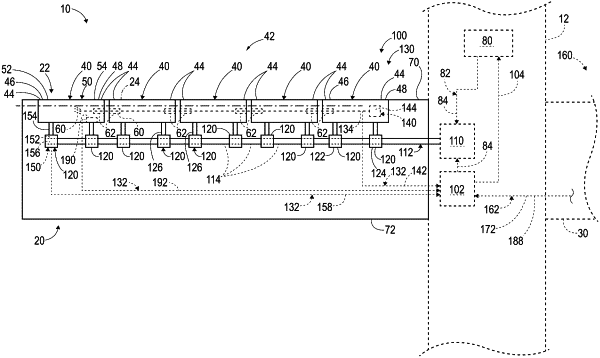| CPC B64C 13/38 (2013.01) [B64C 9/00 (2013.01); B64C 13/16 (2013.01); B64C 13/34 (2013.01)] | 20 Claims |

|
1. A method of utilizing a flight control surface actuation system to operate a flight control surface of a wing of a vehicle, wherein the flight control surface comprises one or more control surface segments, and wherein the flight control surface actuation system comprises:
a control surface actuator configured to be operatively coupled to a corresponding control surface segment of the one or more control surface segments and configured to transition the corresponding control surface segment among a plurality of segment configurations defined between and including a retracted configuration and an extended configuration; and
a skew detection system configured to detect a skew condition in the flight control surface;
wherein the skew detection system is configured to generate a skew detection signal that at least partially represents the skew condition of the flight control surface; wherein the skew detection system comprises:
a skew lanyard configured to be operatively coupled to each control surface segment of a skew lanyard subset of the one or more control surface segments; and
a detection mechanism assembly (DMA) configured to detect a lanyard displacement of the skew lanyard relative to a nominal configuration of the skew lanyard and to generate a lanyard displacement signal that at least partially represents the lanyard displacement; wherein the DMA includes an analog position sensor for detecting the lanyard displacement;
wherein the skew detection signal includes the lanyard displacement signal; wherein the DMA is configured such that the lanyard displacement signal indicates that the lanyard displacement is any of a continuous plurality of values; and wherein the analog position sensor is configured to generate the lanyard displacement signal;
the method comprising:
detecting, with the flight control surface actuation system, a skew condition in the flight control surface, wherein the detecting the skew condition includes:
generating, with the DMA of the flight control surface actuation system, the lanyard displacement signal; and
generating, with a controller of the flight control surface actuation system and at least partially based upon the lanyard displacement signal, a skew condition signal that includes an indication of a magnitude of the skew condition in the flight control surface;
wherein the wing is a first wing; wherein the flight control surface actuation system is a first flight control surface actuation system; wherein the flight control surface is a first flight control surface; wherein the skew detection system is a first skew detection system; wherein the skew lanyard is a first skew lanyard; wherein the DMA is a first DMA; wherein the lanyard displacement is a first lanyard displacement, wherein the lanyard displacement signal is a first lanyard displacement signal; wherein the vehicle further comprises a second wing with a second flight control surface and a second flight control surface actuation system for operating the second flight control surface; wherein the second flight control surface actuation system includes a second skew detection system configured to detect a skew condition in the second flight control surface; wherein the second skew detection system includes a second skew lanyard and a second DMA configured to detect a second lanyard displacement of the second skew lanyard relative to a nominal configuration of the second skew lanyard and to generate a second lanyard displacement signal that at least partially represents the second lanyard displacement;
wherein the generating the skew condition signal includes comparing the first lanyard displacement signal and the second lanyard displacement signal; and
wherein the comparing the first lanyard displacement signal and the second lanyard displacement signal includes calculating a lanyard displacement difference between the first lanyard displacement and the second lanyard displacement and comparing the lanyard displacement difference to a threshold lanyard displacement difference.
|